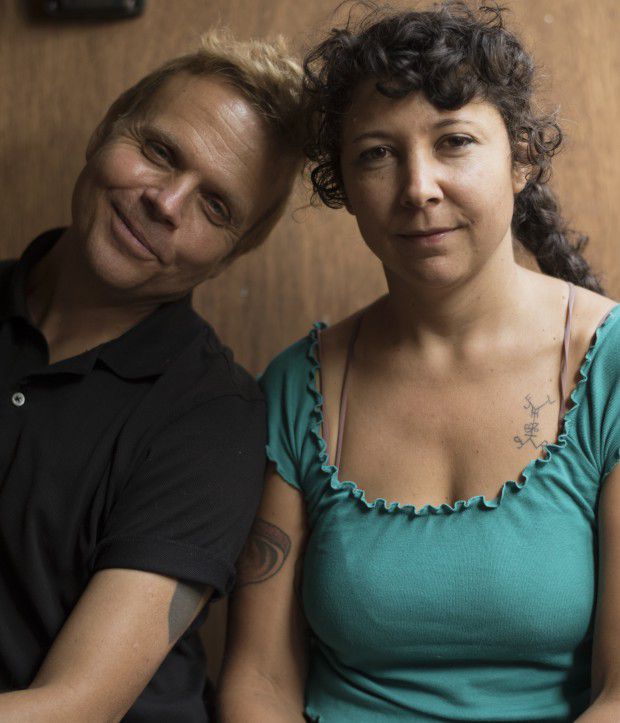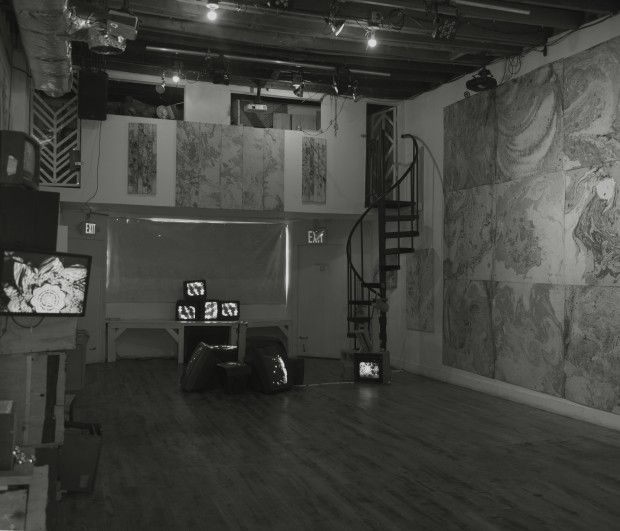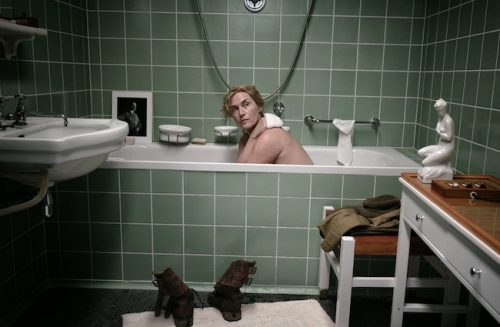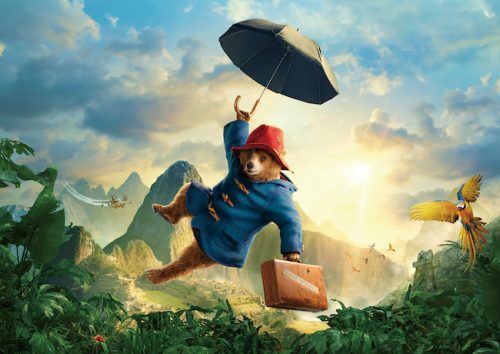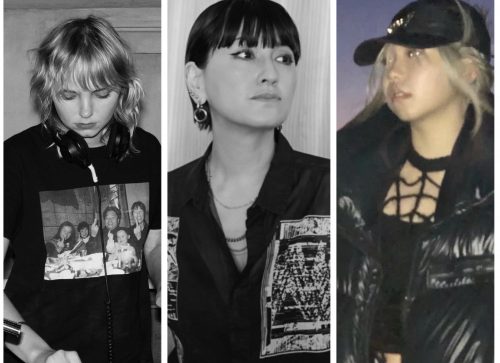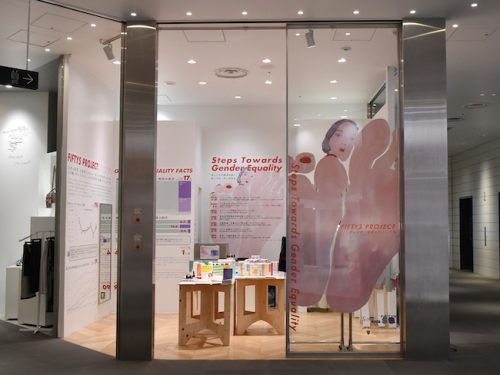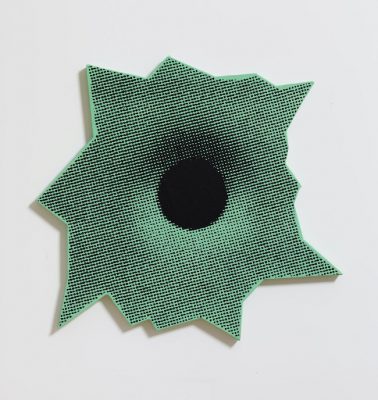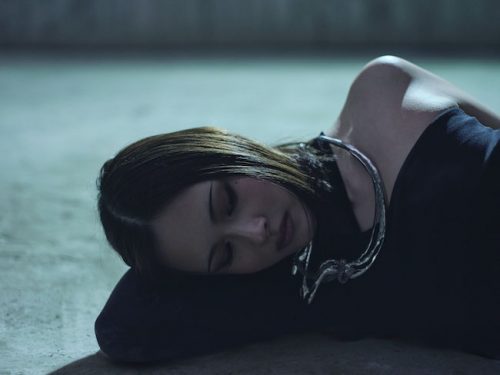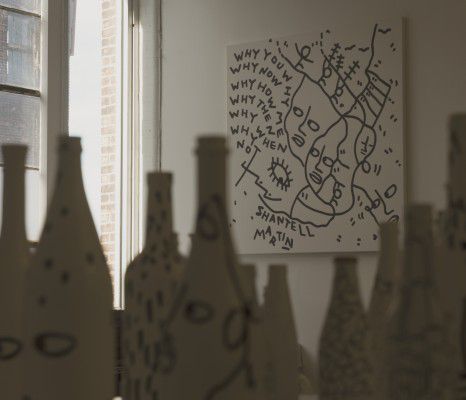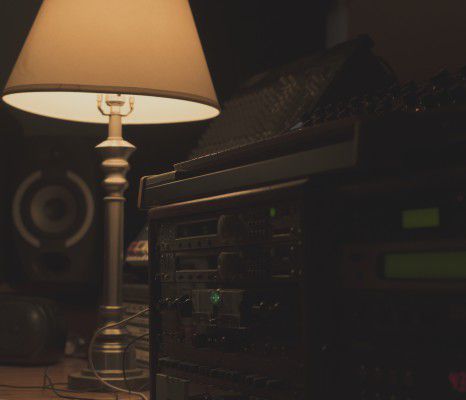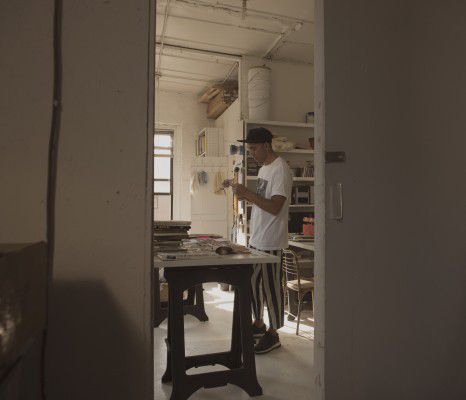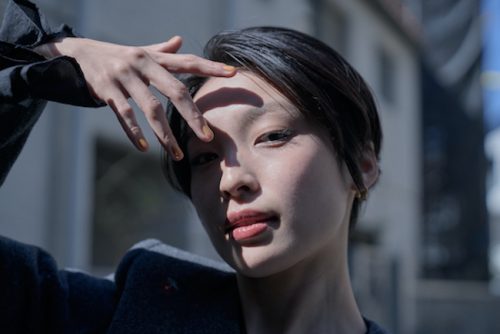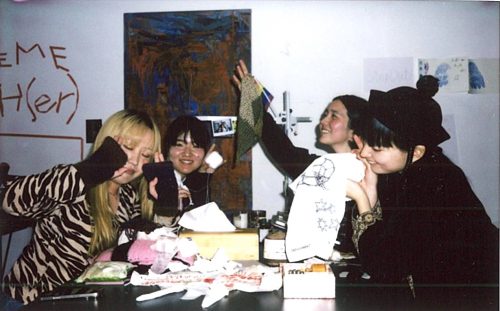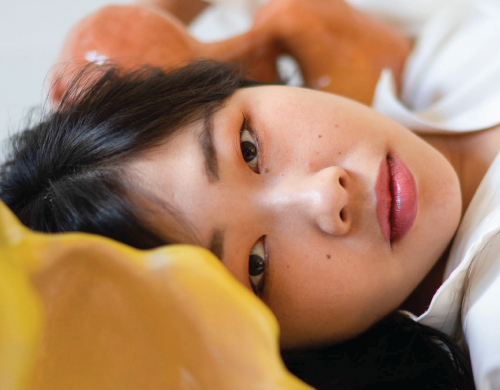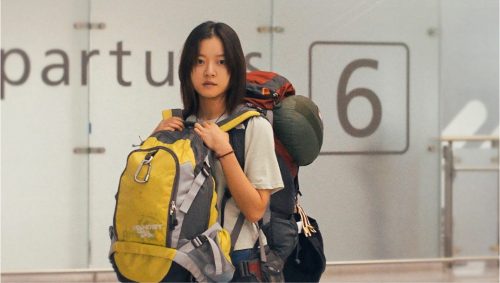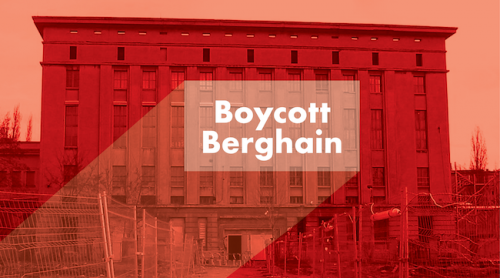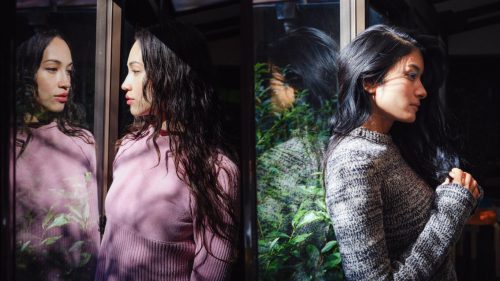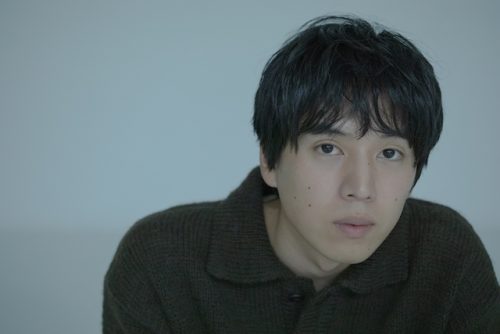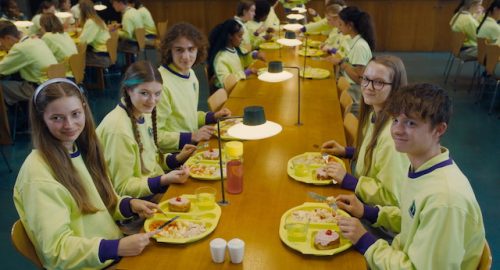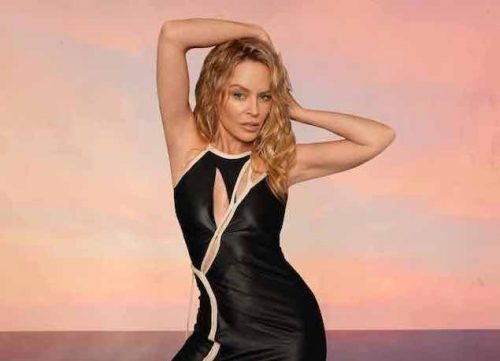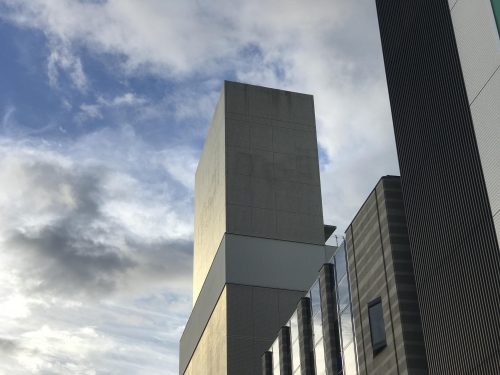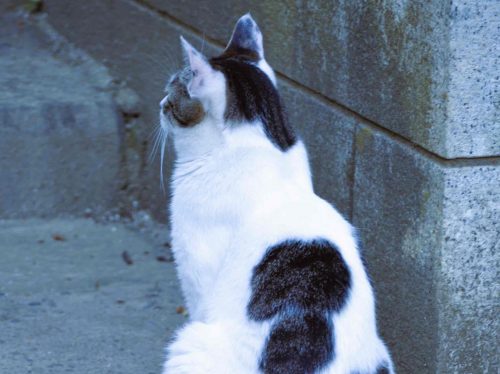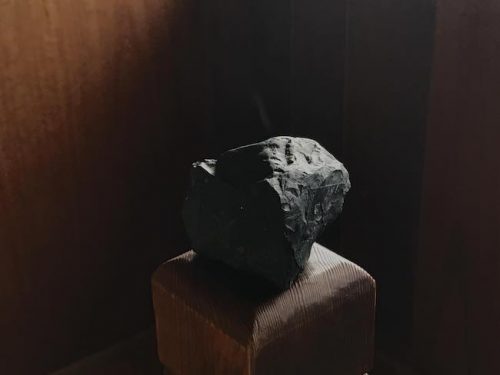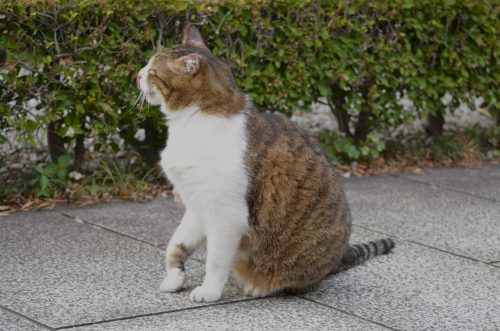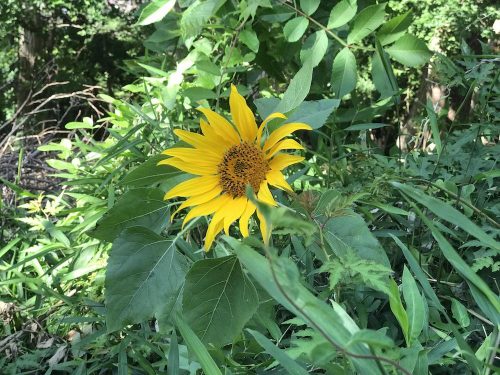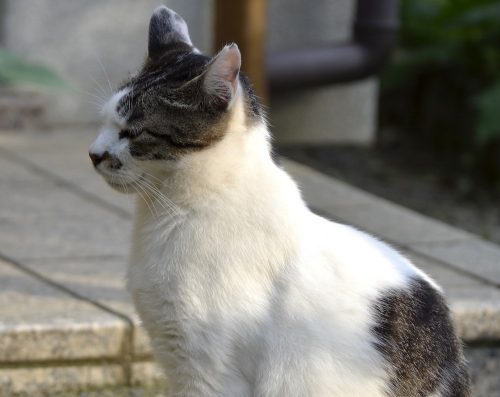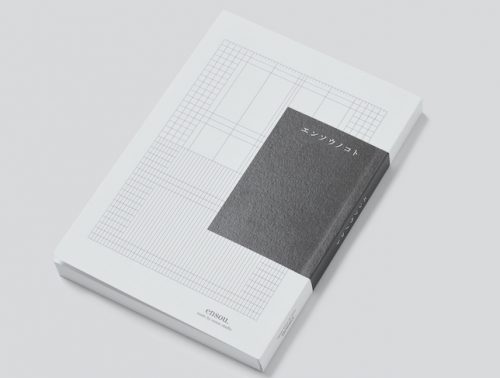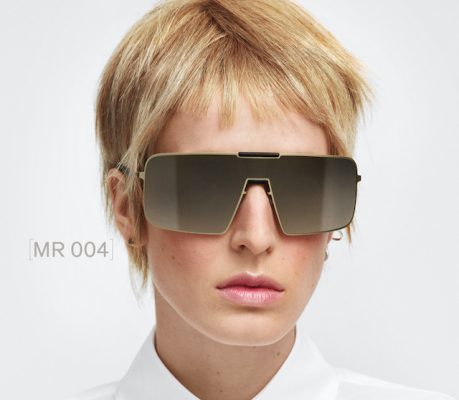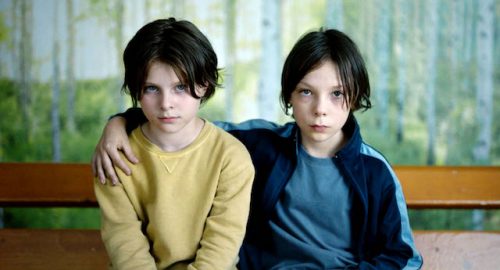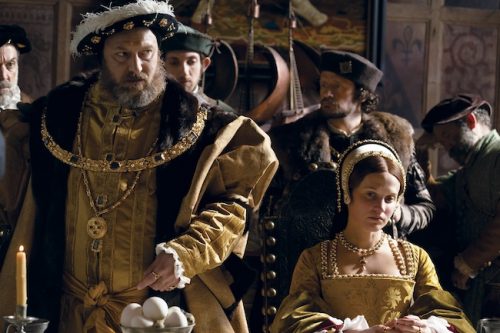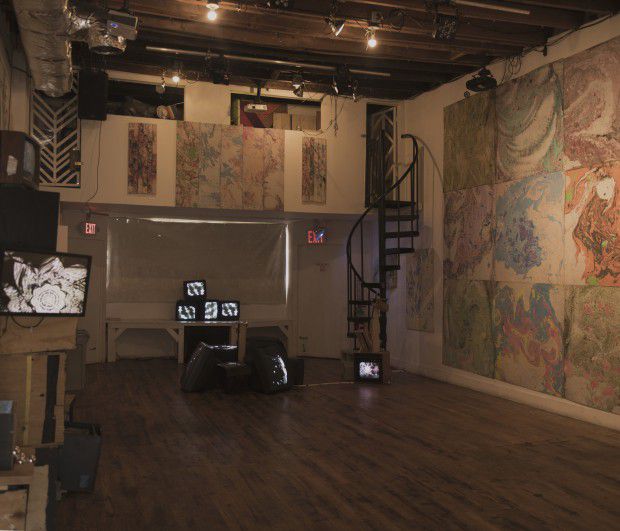
アーティストが集まるエリアとなっているブッシュウィック。その先駆けとしてギャラリー/アートスペース「Secret Project Robot」をオープンしたレイチェルとエリックは、単なるアートの売買ではなく、アート活動をサポートするためにカフェやバーを運営するなど新たなチャレンジを続けている。家族のようにアーティストが集うこの場所は、とてもあたたかく、活気に満ちている。
——今ブッシュウィックにはたくさんのアーティストが集まっていますが、その中でも先駆けてギャラリーを移転させたのがこのSPRですよね。2004年からギャラリーを運営していますが、ギャラリーを始めたきっかけを教えてください。
Erik「ここの前はMighty Robotというアンダーグラウンドなクラブを運営していて、当時のパーティにもプロジェクションやアート的なものはあったけれど、もっとアートを増やして、大きなインストレーションもやりたかったんです。誰もそういうアート空間を作っていなかったですしね。アートギャラリーで行なっている素敵なインスタレーションはあったし、アートを少し取り入れたパーティも存在していたけど、大きなインスタレーションの中でアートの一部として人々がパーティやパフォーマンスをすることはなかったんです。そこでMighty Robotを閉鎖して、私と当時スクリーンプリントショップをやっていたK-rockで一緒に建物を借りて、友達に住居人になってもらって、アートとパーティを融合させたSecret Project Robotができました」
—— なるほど。展示するアーティストも場のエネルギーに共感するような人を選んでるんですか。
Rachel「“シーンを空間が作るか、空間をシーンが作るか”という質問は常にありますよね。私たちに似ている人たちは、昔からずっといて。The Knitting Factoryみたいなシンプルな会場で演奏したい人は、テイストに合わないからここでライヴしたがらないと思います。でも、ここに来て、『最高だ、演奏したい』と言ってくれる人もいて。気に入ってくれる人たちがいつもいるので、どんどんシーンが大きくなっていくんです。音楽を作っているアーティストや、アートを作っている音楽家とずっと関わってきているから、ここでは音楽とアートもオーバーラップしていきます」
——いいアーティストやパフォーマーの条件は?
Erik「イベントの形式上制限はあって、丈夫で消耗に耐えうるアートでなくてはいけません。貴重すぎてはダメだし、人々が登っても平気なようなもの。パフォーマーに関しては、アーティストが作った空間の中で演奏できなければいけない。主な制限はそんな感じですね。あとはセンスが合うか、かな」
Rachel「派手なヴィジュアルも大切です。例えば、壁にポツンと作品があるようなミニマムな感じはここには合いません。たくさんのクレイジーなアートを求めているんです。現在展示しているものは派手さに関しては中くらいですが、普段は派手なショーをしたいから、それに合うアーティストを探しています。
アンダーグランドのアーティストたちの多くは、商品としての価値より、心を込めて作ったという価値を大事にしています。もちろん作品は大切だけど、売ることにはあまり執着していない。だから誰かがパーティで暴れても作品を楽しんでいるからだと捉えるし、多くの人が見てたくさんの愛を注いで欲しいと思っています」
Erik「多くの人が触れるほど、アートがもっと活き活きとするんですよ」
Rachel「アートの価値より体験の価値を重要視しているから、同じような価値観を持っているアーティストを選んでいると言えますね」
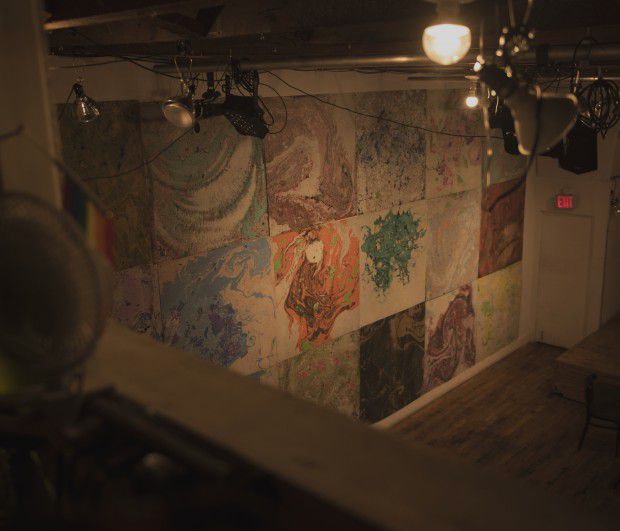
——ここならではの特色についてもう少し教えてください。
Rachel「今見える物のほとんどは、私たちが作り上げました。私たちの労働であり、私たちのプロジェクトであり、私たちの愛がこもっています。その他は友達に手伝ってもらっていて、この壁を立てたのも私たちと友達です。アーティストが家族の一員のようで、それが一番の特色かな。他の場所はまっさらな空間が多いけれど、ここは作り上げた人の思い出や気持ちでいっぱいなんです。新しいビジネスモデルを試している部分も特色と言えるかもしれません。私たちはアートを売っているけれど、売るのが下手なんです(笑)。その代わりにバーの売り上げでアーティストをサポートしようとしているところも、他のギャラリーとは違います。バースペースはパフォーマンススペースをサポートしているんです。それがうまく機能してギャラリーを長く持続して、アートをいろんな人にアクセシブルにできるといいなと思っています」
Erik「NYのギャラリーやミュージアムはすでに有名になっているビッグなアート中心。ほとんどのギャラリーもお店のようで、服をお店に買いに行く感覚でアートをギャラリーに買いに行く場所になっています。アートやインスタレーションを常に展示しているスペースで、売ることが目的になっていないのは、僕たちを含めてごく一部だけ。ここは店じゃなく、アートを体験する場所なんです」
Rachel「ヨーロッパではこういうあーとスペースはそんなに珍しくないけど、アメリカでは何でも値段がついているし、博物館の展示もアートの価値を上げるためになる時もある。そういう金銭関係から離れて、アートとアーティストと空間と体験を大事にしたいと思っています」
Erik「ここの従業員もみんなアーティストで、みんなここで生活費を稼いでいるんです。僕たちは頑張って働いて、アートコミュニティーをサポートしようとしているんですよ」
Rachel「みんなで協力しあっているんです」
Erik「そう。友達も全員アーティストだしね」
Rachel「以前は他の仕事もあったから、週に2回しかパーティを開いていなかったけれど、今は週7でやっているし、パートナーが6人も増えたから色々できるんです。みんなが金銭的にも個人的にもこの場所に興味深々だから、もっとファンクショナルになりました。オープンでバーができたことで法的申請もしたし、ちゃんとしたプロジェクトになったんです」
——こういうスタイルのギャラリーはやはりNYでは珍しいんですね。
Rachel「私たちは長い間ギャラリーをやっているけれど、流行りはころころ変わっています。2004年に始めた頃はDeitchが人気だったから、みんなカラフルなアートを作っていました。でも今はNew Museum系の綺麗でシンプルなアートが流行っているから、私たちのスタイルとは違うんです。でも、ちょっとずつカラフルなものは増えてきています」
Erick「ギャラリーも入れ替わりますしね」
Rachel「どこの大学院が人気かも関わってきます。2000年代前半はみんなRhode Island School of Designから卒業していて、プロビデンスのシーンの影響が強かった。今はBardがその立場かな。Bardは特殊な学校なんですが、そのスタイルがNYCのアートシーンに広まっています。私たちは長い間活動しているから安定しているけど、それでも人気は上下しますよ。ちょっとずつここのスタイルの人気が戻ってきているけれど、もっと復活してくれるといいなと思います」
——個人的な意見としては、政治が悪い時ってアートが元気になるように思えるのですが。
Rachel「いろんな理由があるけど、みんな今は発散したい気持ちがあると思います」
Erik「みんなもっと関わろうとしているし、もっと態度をはっきりしようとしている」
Rachel「前のスペースを閉鎖して、8月から12月まではスペースがなくて。その間に選挙があって、私たちの選択肢は逃げるかすぐに戻ってくるかでした。このスペースを作ると決めたのは、政治的な理由もあったんです。こういうコミュニティやアートシーンの存在を世の中に伝え直すこと。今みたいな時こそ、特にこういう場所が必要だと思ったのです」
——アーティストとしてNYに生きることはやっぱりヘビーなことだと思いますか。
Rachel「ええ、常に。人は仕事を頑張らなきゃいけない環境にいると、大事な作品を作れるように頑張るんです。バーリンなどのもっと生活費が安い街に引っ越すと、あまり制作をしなくなる人もいます。NYはいい意味で競争的。みんながたくさん活動しているから、自分ももっと頑張らなきゃと思うんです。刺激しあっていて、全てが高くて、ちょっとマニアックかも。LAなどにも住んだとこがあるけれど、ここのエネルギーは独特ですね」
——なるほど。私が今回NYに来て結構ビックリしたのは、アーティストのSNSのブランディングがすごくしっかりしていたことなのですが、SNSであったり、テクノロジーがアートにもたらす影響に関してどう思いますか。
Rachel「複雑ですよね。プロモーションツールとしては有力ですが、政治などに関しては、Likeを押すことと、デモに行ったり、アートを作ったり、実際何か行動を起こすこととは全然違います。人を繋げるのにはいいけれど、使い方には気をつけるべきかな」
Erik「諸刃の剣だと思います。フォロワー数やいいねが多いからといって、その人の作品がいいわけじゃない。作品のクオリティーと作者の人気が混同されて、人気者コンテストになってしまうのが悪い面かな。でもSNSに投稿して、全世界の人に見てもらえるのは素晴らしい。世界中の人がインフルエンスし合って世界が狭くなるのはとても良いことですよね。良い点も悪い点もあるから、うまくバランスをとらなければいけないと思います」
Rachel「500回Likeが押されていても、いい作品なのかは分からない。でもFBやYouTubeで有名になった人も増えて、それも一種のアートなのかもしれません。当時のAndy Warholみたいな感じで。あと、クールなアーティストを探すのにも良いツールだし、新しい発見をするのには最高ですよね。でもNYみたいな街にいると、ずっと画面を見て、人との関わりを避ける傾向もあるからやはりバランスが必要かな」
——そうですね。本来は自分の作品についてだけ悩めばいいのにその作品をどう見せるかなども考えなければいけない現代は、チャンスも多いけど大変ですよね。
Rachel「ええ。The HoleというギャラリーにはDeitchのアーティストも関わっているけど、Deitchとは違って、商品をどう美しく見せるかが重視されているんです。SNSはインディペンデントなアーティストが作品を売ったり、知名度をあげるのには良いけど、ネットでの見せ方ばかりに集中してしまうと危ないと思います。世界はどんどん磨かれて綺麗になっているけど、今も苦労している人はたくさんいるし、ひどいこともたくさん起きているので、ネット以外の世界を忘れないようにしたいです」
Erik「特にここのアートに関して言えることかもしれないけど、SNSでかっこいい写真を見るのと、実物を見て体験することは全然違うんです。パーティを開く意味もそこにあって。SNSでパーティーを見て楽しそうな雰囲気が伝わってきても、実際そこにいたのとは全然違うのに、人々は本物の体験をSNSで置き換えようとしてしまう。画面を通して何かを見るのもある種の体験だとは思うけど、細かいとこに気づいたり、音楽を体で感じたりする実体験とは違う。SNSはいいツールだけど、現実とはまた違う種類の体験として捉えた方がいいと思いますね」
——最後に、今注目しているアーティストがいたら教えていただけますか。
Erik「Raúl de Nievesという長年の友人がいるのですが、知名度がここ一年で爆発的に上が理ました。彼はどんどん上手くなっていくんです」
Rachel「彼のことは15年ほど知っているけど、本当に努力家なんです。昼間はずっと働いて、夜はパーティ。どうやっているのかさっぱりわからないくらいハードに活動していて」
Erik「ここのパートナーのMonica Mirabileは、FlucTというムーブメントアートに関わっていて、最近注目を集めています。通常のダンスとは違って、ダンスとパフォーマンスアートの融合で、とてもクールですよ」
Rachel「ネットで調べたら出てくるので見てみてください。体を激しく床にぶつけたりするんです。トラディショナルなパフォーミングアートだけど、動きがとても独特。ここのメンバーは私たちと、FlucTのMonicaの他には、Jakeという演劇のようなパフォマーンスをするアーティストがいます。最近、Bushwickには演劇の要素も増えているんです。Kathleenというもう少しトラディショナルな踊りをしているメンバーもいるんだけど、彼女のダンスのテーマは『儀式』で、昔と現代の儀式をかけ合わせたアイデアです。あとは、Daveというミュージシャンもいます。彼はオーボエでドローン・ミュージックを吹くんです 。あとWillというヴィジュアルアーティストで、音楽活動もしている友人がいて。Adrianはキュレーターだけど、DJもやったり。彼の家族はメキシコ出身で、視点が私たちと少し違うから、いろんな考え方を取り入れられるし、クールなんです。ここの人はみんな素晴らしい作品を作っている。みんな友達を10人ずつくらい連れてくるから友達の輪がどんどん広がっていって、大家族みたいに生活しています(笑)」
Secret Robot Project
https://www.secretprojectrobot.org
photography Diego Garcia
text Ryoko Kuwahara
——So the reason I wanted to interview you is because, while Bushwick is now a place known for its artist community, you were some of the first people to move here. We’re aware that you started this gallery in 2004, but what made you want to start galleries in general?
Erik: We had a space before that called Mighty Robot that was like an underground club venue with bands and parties. And, you know, we wanted to do more art with bigger art installations. Like a lot of the parties were there’d be projections always and art things, but we decided we wanted to make the parties more of an art environment. And no one was really doing that. There were like art galleries that had great installations and there were great parties that had art elements, but there were none that just were like “Oh this is an art work installation with big parties and people performing in a part of the art!” So we sort of closed our space, and me and K-rock, who had a screen print shop, rented this building that we then got a bunch of our friends to move into. And that’s actually when Secret Project Robot started and it was really to sort of merge the art and partying and get more involved in art installations.
——So when you select artists to have displays or perform here, do you choose people who resonate with your vision of combining partying and art?
Rachel: I think there’s always the question of, “Does the space make the scene, or does the scene make the space?” You know, but there’s always been a group of people who have been like-minded, who wanted to be more like us. The people who would rather play at The Knitting Factory, like just a venue, don’t really wanna play here. They don’t like it. But the people who come here and think it’s amazing and they wanna play here. And we’ve always just found people who are excited, so it sort of reciprocates and creates a bigger scene of more people who like this sort of thing. But we’ve always sort of been in touch with artists that are musicians and and musicians who are artists, so there’s a big overlap in sort of the music and creative parts too.
——Do you guys have requirements for artists, either musically or visually?
Erik: There’s certain constraints due to events. The art has to be kind of durable and expendable. It has be not too precious and people should be able to climb on them because there’s events and parties. For performers, they also have to be willing to perform within that structure that the artist made. Those are the main constraints and of course, just like taste differences and stuff like that come into play.
Rachel: I think we also just seek people who aesthetically we’ve always been a little bit more maximalist. So, some of the things that are like just one thing on the wall isn’t good for us. We want more, always. More art, more crazy. The ones we have now are maybe a little bit in the middle, but usually, we want like really full shows so we’ve always tried to find artists who want more of that. But also, people who like the underground has a sort of thing where like art is precious because you put your heart into it and not because as a commodity. So, it’s not only precious because it’s for sale. It’s sort of precious because you made it, but you’re not like so focused on it selling. So you don’t mind if people are going crazy and having fun because that actually brings more preciousness and that brings more love into it the more people see it and are surrounded by it.
Erik: The more people experience in it and engage it brings it more to life.
Rachel: So it’s like placing the emphasis not on the price of the art, but the price of the experience and we’ve always sought like artists who do that, too.
——So we kind of touched on this before, but in an environment where there’s so many galleries, like NYC and Brooklyn, what are some characteristics of this gallery that are precious to you?
Rachel: Well, there’s lots of them. For us, everything you see, pretty much, we built. So it’s like our labor, our project, our love. And everything we didn’t build was with the help of our friends. So, this is like a place where the people who helped us put up the walls are our friends. It’s like making more families of people. Even if they’re not artists, they’re part of the Secret Project Robot family. So, I think that’s like the most special thing because a lot of places, it’s just a blank space. But here, even when it’s empty, it’s like full of all of the people who’ve made it this way. But I think also it’s special because we’re trying something new for our business model, you know, because we don’t sell art. Well, we sell art, but we’re not good at selling art. We’re trying to have the bar support the artists, which is like a different from other places. So, we’re trying to create a new thing that makes us sustainable for a really long time and we can actually keep on making more art accessible for more people. So the business model is like a new thing for us to try to think of a way to raise money, so that we can keep on having projects in here, so that room totally supports that room.
Erik: Also, in New York, most galleries and museums are mostly concerned with established art, historical art, art that’s already big. The galleries are just consumer stores, so you’re go into a gallery to buy a piece of art, like you go into a store to buy an outfit. And most galleries in NY are that way and we might be one of a handful that actually have art installations and art all the time, where the purpose isn’t to sell it. It’s not a store, it’s an experience.
Rachel: Like in Europe, it’s more normal to have an art space. It’s not that strange. But here in America, I think everything has a price or even the museum system is sometimes in function to make the art prices go up. So it’s like this kind of relationship that we’re trying to step away from and become about the art and the artist and the space and experience.
Erik: And all the people that work here are artists. So they earn their living through here. We work really hard to support the arts community and stuff.
Rachel: it’s like a cooperative.
Erik: Yeah, All our friends are artists too.
Rachel: And they’ve been helping. Because before, with the old space, we only had parties like two days a week because we had other jobs and had to do other things. But now, there’s seven days a week here, so we have six more partners who help with curation and stuff. So now it’s much more like a community space and they all have a financial and personal interest in this space. I think that makes it more functional and it’s also like for everyone. It’s just sort of become like a real project, with being more open and more legal.
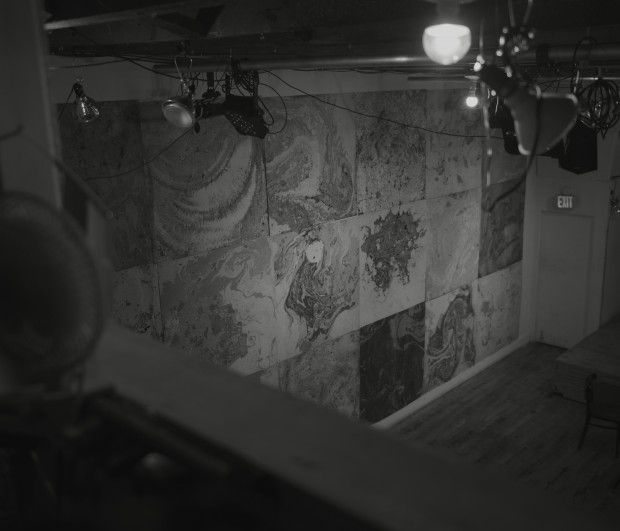
——Do you think this kind of gallery style is rare in New York?
Rachel : I think it comes and goes and we’ve been around for a really long time now. So when we first started in 2004, it was when Deitch was really popular, so everyone was making really cool bright art, you know. Now, we’re not as popular aesthetically because everything is very like New Museum. Very clean and minimal. But I think now, also, it’s coming back, with a little bit more colors. It was maybe less popular for a while, though.
Erik: and spaces come and go you know
Rachel: We noticed it also depends on whatever graduate school is very popular at the time. For the early 2000s, everyone was coming out of RISD and it was _(coudln’t make out. Something about brown?)_. The Providence scene was feeding everything and now everything is very tied to Bard. Bard has a very specific academic stance and you can see it proliferating in the NYC art scene. I think that because we’ve been around for a long time, we’ve just kinda been steady and sort of sometimes more popular, sometimes less. Sometimes, people come here and think, “Oh, this is cool!” and maybe it inspires smaller spaces to do the same thing, but I think right now, it’s coming back a little bit. We hope more.
——I feel the same way. The last time I came to NY was actually around when Deitch was popular and the reason I decided to make this visit was because I feel like the art scene is reviving right now. I personally think that it maybe because the art scene becomes more lively during times of political turmoil.
Rachel: Yeah yeah i think there are so many factors, too, but everyone needs some outlet now right. Obama was too good for everybody.
Erik: Yeah, I think people are engaging much more and wanting everything to be much more intense.
Rachel: So we closed our old space this time last year, and we had no space from August until December. And then the election happened, and it was either run away or run back in and engage. Decisions about this space were decided slightly on politics, like the world needs to be reminded that there’s still communities and art scenes in it and they’re more important now than ever, you know, with what you’re saying. It’s really important for us to have these spaces when we’re faced with trauma and all the things that are going wrong. So many.
——Even though the art scene is reviving, you still hear a lot about the financial struggles of being an artist in NY and about people moving to LA for that reason. Is it tough to do art in NY?
Rachel: Yeah always. it’s like we always say, you know, when you need to do more, you do more. When you have to work really hard, you work really hard to make sure your art is important. I think sometimes, people go to other places, like Berlin for example, where it’s so that cheap you don’t have to work very hard, so people just don’t. NYC is so competitive in a healthy way. All the artists are like, “I played seven shows this week and I’m doing five art shows and I’m going to Miami and I’m going to here…” and everybody’s like, “I have to get more busy too!” And so maybe we all feed each other. It’s positive competition. I have to do more because they’re doing more. I have to make more paintings. It’s maniacal in a way. LA or no other city that I’ve ever lived in has that energy.
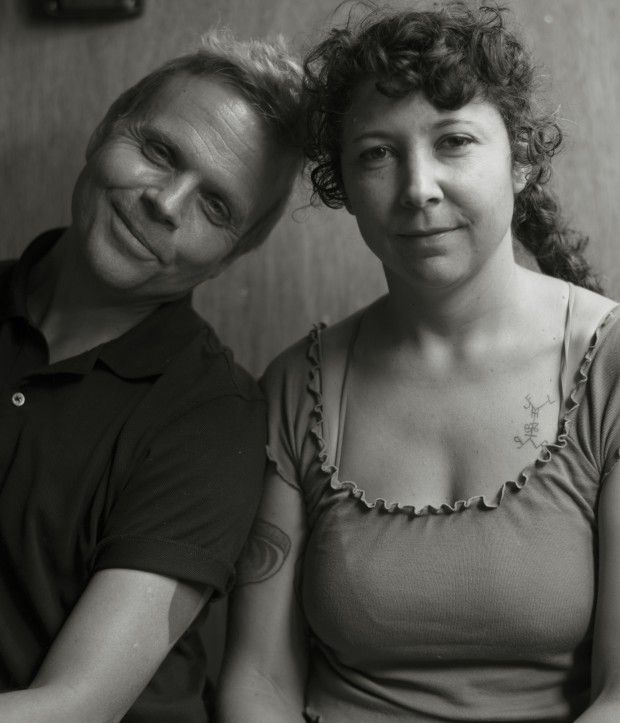
——Throughout this visit, I thought that one interesting thing was the way people brand themselves social media in NYC compared to other cities like LA or places in Europe because everyone has established their own aesthetic. It’s so effective. What do you think about the effects of social media on art?
Rachel: It’s tricky, right? Yeah, I mean, for me, I think it’s effective as a promoting tool, but on politics and greater conversations, I think saying you’re like clicking that you like something isn’t the same as saying youre at a protest or making art or like actually showing up. I think it’s really good for connecting people, but it’s very slippery and you have to be careful because sometimes, all of a sudden, you’re signing online petitions, but it’s not the same as actually like supporting something.
Erik: It is a very double-edge sword in that it’s easy for people to start thinking someone’s art is good just because they have so many followers on Instagram or Facebook or they get so many likes on something. That photo got so many likes, but that doesn’t mean it’s good. It just means they’re popular. It starts to confuse popularity with what is good and it’s sometimes starts to undermine the content of stuff. It just becomes a popularity contest, which is the negative aspect But it’s great in that you put it on social media and then the whole world can see it. People all over can start to influence each other and artists can influence each other everywhere and it makes the world smaller, which is good. So it is a give-and-take and something we all have to learn to balance and learn to grow into it, but it’s happening fast, so we have to go fast.
Rachel: It’s hard to get context from a photograph without the words, so sometimes it’s just “500 likes… Does that make it good art or bad art?” I think it’s not the same thing as whether the artist is good or bad, but all of a sudden, and maybe that’s its own form of art, there’s this sort of FB phenomenon and all these YouTube famous people. Sort of like Andy Warhol in that moment, you know.And It’s cool for finding all these cool artists. I didn’t know this, but there’s this small little art scene in the Dominican Republic in San Domingo, but I didn’t know that. I’m finding out that these kids there are making similar things and I only found it through social media stuff. And now, I have all these people that I’m following that I just think are so cool that they’re doing things there, like we’re doing in NY! And now, I’m having conversations and maybe they’re gonna come here, so it’s really great for finding new things. But also for NY, its really bad because we’re all just on our phones all the time, so it’s almost like our protection, like “Don’t talk to me.”
——One reason why I’m so intrigued by social media because artists are now so preoccupied about how they present the work on social media instead of just focusing on how their art actually looks and it seems like additional hard work.
Rachel: That what I think I was saying. The Hole has the artists from the Deitch project, but it’s not the Deitch projects, it’s just commerce and making it look beautiful for the photo. But, like for me, it’s good for an independent artist who can sell something, or to get their art out there. But the thing is dangerous when it becomes so much about how everything looks online. Everything is looking beautiful, and the whole world is more polished and beautiful, but people are still suffering and things are still bad.
Erik: With a lot of art, particularly art here, a photo could look cool, but it doesn’t maybe capture the experience you would gain. And I also think that’s one of the aspects of having events and parties because you can see a photo of a party and you can know that party was cool and probably great to be at, but that’s very different from the experience of having been at the party. So we start to substitute social media and the internet for actual real experience. I mean it’s an experience unto itself it’s a unique experience, looking at a little phone or computer screen, but it’s not like a full life experience. It’s sort of like an un-life experience. It’s like the undead versus the living experience, where you walk in and experience stuff you see the small little details of stuff or feel the music as it plays. It’s a great tool, but it should just be thought of as that, but maybe not as an experience, or thought of as its own little experience.
——Moving on, can you tell us about any artists you are into right now?
Erik : As for artists, Raúl de Nieves, one of our oldest friends, has blown up this past year. His works just keeps getting better and better.
Rachel: And he’s like one of the hardest working artists. We’ve known him for like 15 years, I think. He parties all night, works all day. We don’t know how he does it. We have another space called Flowers. It’s more of like a cafe, but in the back, we have a gallery and we recently had this show which was like all cloth and there was a cave made out of cloth and it was so cool. It was all these girls who were doing different kinds of weird stuff using different fabrics. Braiding and weaving, but not like in a traditional way, so that’s what’s exciting about art in different places and people doing things.
Erik: One of the partners involved here, Monica Mirabile, is in this movement art thing called FlucT and that has really taken off in NY and also all over. It’s sort of like dance, but it’s not dance in a traditional sense. It’s like where dance and performance art merge. Three of our partners are involved in that movement and dance scene and that’s really cool.
Rachel: And it’s kind of about the physical body and the patriarchy, so it’s using the body in a different kind of way. It’s in a traditional narrative of performance art, but the way they do it, it’s like, “How did they do it?” when you look at it. For the people who are involved here, there’s us, and then Monica, who’s the person who does FlucT, and then Jake, who is a performance artist too, and sort of does a little bit more theatrical pieces, but like where theater meets performance art. I think in Bushwick, we’ve become much more performance arts-based too, which is a big difference than before. There’s Kathleen who does a lot more traditional dance, but all of her stuff is based in these ideas of how modern ritual meets past ritual, which is very cool. And there’s Dave, who is a musician. He plays oboe, but he does drone music through it, so its like you know changing something that’s classical.And there’s our friend Will, who is like a visual artist, but he also does some music. And then Adrian, who is sort of more like a curator, but he’s into the DJ scene. His family’s from Mexico, so he has a different point of view that’s very helpful for curating and DJing and changing the perspective a little bit, which is really cool. Everyone who works here is making really cool stuff. Also, each partner has like 10 friends, so there’s 80 friends, and then those friends have friends, and there’s all these new friends, and it’s like this little big family.
Secret Robot Project
https://www.secretprojectrobot.org
photography Diego Garcia
text Ryoko Kuwahara
